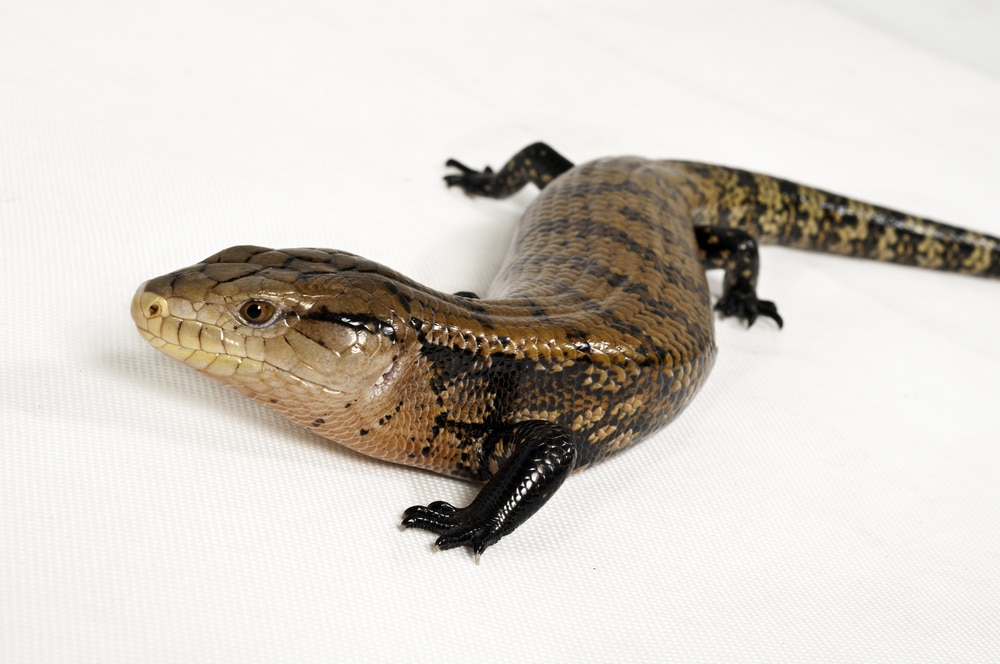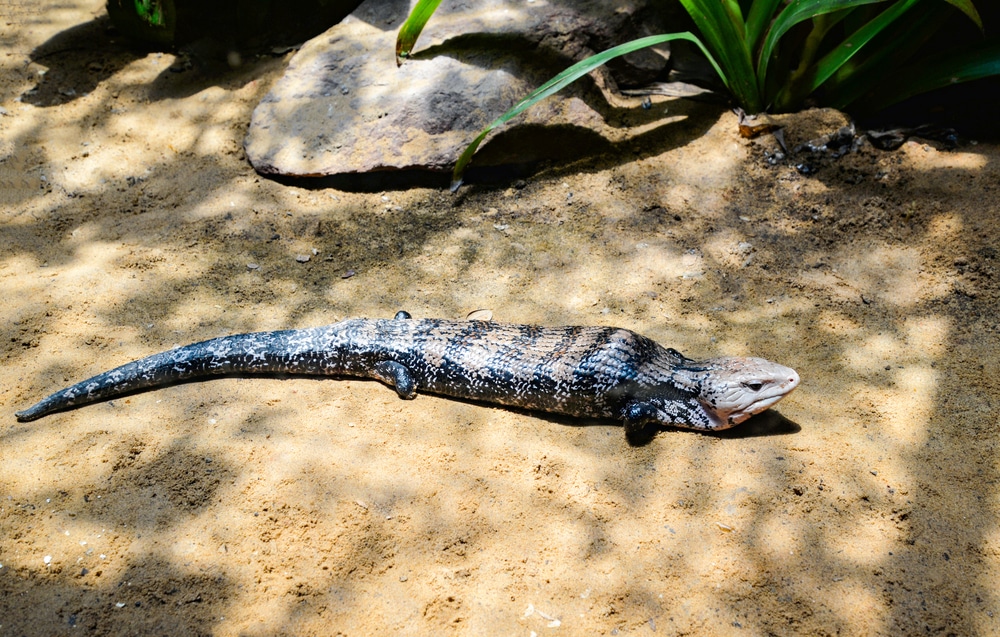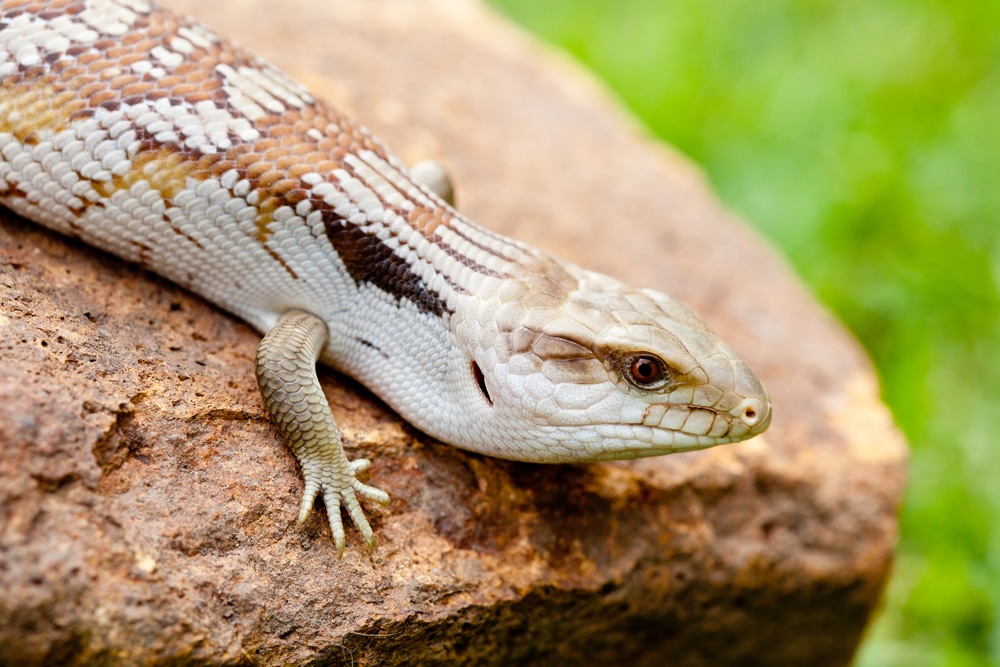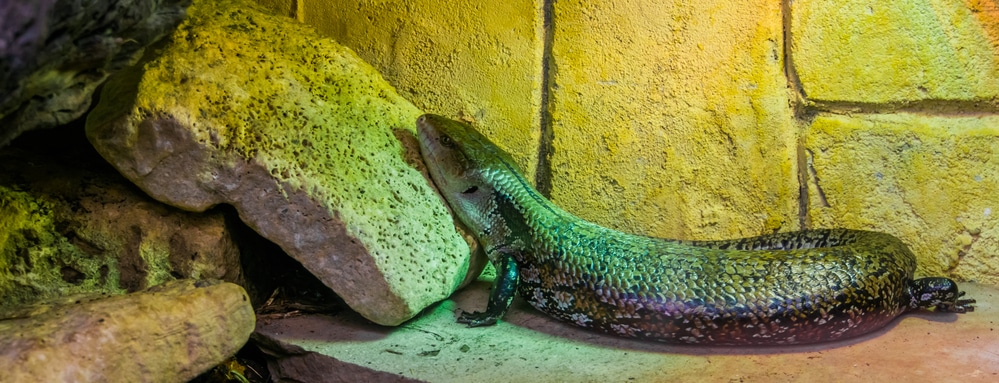Named for their distinctive blue tongues, blue-tongued skinks are medium-sized lizards that are very popular pets among reptile enthusiasts.
In fact, because these lizards are both interesting and easy to care for, they can make excellent pets for keepers of all experience levels – even first-time keepers, who’ve never cared for lizards before.

But to achieve success with your blue-tongued skink, you’ll need to familiarize yourself with the specie’s biology and natural history, as well as the basic care regimen most experienced keepers employ.
We’ll try to help you do so below, as we review the lifestyles of these lizards, outline the best way to set up a captive habitat for one, and explain how to feed and interact with these interesting animals.
Quick Navigation
Types of Blue-Tongued Skinks

Although scientists debate some of the details regarding the blue-tongued skink family tree, most recognize seven different forms that occur across their wild range. These include:
- Pygmy blue-tongued skink (Tiliqua adelaidensis)
- Indonesian blue-tongued skink (Tiliqua gigas)
- Centralian blue-tongued skink (Tiliqua multifasciata)
- Blotched blue-tongued skink (Tiliqua nigrolutea)
- Western blue-tongued skink (Tiliqua occipitalis)
- Common blue-tongued skink (Tiliqua scincoides)
- Irian Jaya blue-tongued skink (Tiliqua)
Scientists haven’t yet coined a species name for the Irian Jaya blue-tongued skink, but most agree it is clearly a distinct form. Some researchers and lizard keepers recognize subspecies of a few of these species, while others do not.
Note that the shingleback lizard (Tiliqua rugosa) is a member of the same genus as blue-tongued skinks and shares a number of similarities with these lizards. However, it is generally not lumped in with the blue-tongued skinks by North American hobbyists. With that said, most of the care requirements outlined below will likely work for shingleback lizards too.
Geographic Range and Habitat of the Blue-Tongued Skink

As a group, the blue-tongued skinks range across Australia, Tasmania and New Guinea. However, different species occupy different ranges within this area. The Indonesian and Irian Jaya blue-tongued skinks hail from the island of New Guinea, while all of the other species are native to Australia.
The Centralian blue-tongued skink is found in the northwestern portion of New South Wales, while the blotched blue-tongued skink is found to the southeast. The western blue-tongued skink is found along the southern and western portions of the continent, and the Pygmy blue-tongued skink is native to the area surrounding Adelaide. The common blue-tongued skink is primarily found along the eastern coast, but it is also native to Tanimbar and a few other islands of the region.
Across this vast range, blue-tongued skinks frequent a variety of different habitats, ranging from damp rainforests to arid, desert-like regions.
Basic Biology and Natural History of Blue-Tongued Skinks
Aside from the pygmy blue-tongued skink, which only reaches about 8 inches in length, most blue-tongued skinks are medium-sized lizards, who reach lengths of about 20 to 25 inches. They are primarily terrestrial animals, but they may climb rocks or low-lying tree branches from time to time.
Blue-tongued skinks are opportunistic omnivores, who consume a variety of different foods, ranging from berries to slugs to smaller lizards. They may also consume carrion from time to time. These lizards will generally grasp prey and then bite down on it a few times with their strong jaws before swallowing it.

Blue-tongued skinks are primarily diurnal (active during the daytime), although there are scattered (and unconfirmed) reports of some species shifting to a nocturnal activity pattern during the height of the summer. Those living in areas with warm year-round temperatures tend to remain active throughout the year, but those living in the southern portions of Australia may become dormant for a short period of time during the winter when low temperatures and food shortages make activity challenging.
Blue tongued skinks are hunted by a variety of large and medium-sized predators, most notably including birds of prey, large snakes and monitor lizards (goannas). Their first line of defense is to simply remain undetected by hiding or relying on their cryptic body coloration.
If these strategies fail, the lizards will use their namesake tongues in an attempt to frighten away the predator. In doing so, they’ll typically adopt an aggressive body posture, open their mouth, and wiggle their tongue in a menacing fashion. Because blue is a fairly rare color for terrestrial animals, it is often shocking to the predators, who’ll decide to leave the lizard alone and look for food elsewhere.
If their tongues fail to dissuade the predator, the lizards may resort to biting. And while their teeth aren’t very sharp, these lizards can inflict a painful bite, thanks to their strong jaws.
Most female blue tongued skinks are capable of reproducing once per year if they can secure enough food to prepare their bodies. Blue-tongued skinks give birth to live young, rather than depositing eggs, and the young are generally born between December and April in the wild. The young are not given any care from the parents, and they likely mature in about three years.
Blue Tongue Skink Care: Setting Up and Maintaining the Habitat

Now that you have a basic understanding of blue-tongued skinks and their lifestyle in the wild, we can begin discussing the best way to maintain these lizards in captivity. But it is important to note that many keepers employ different strategies and techniques when designing a blue-tongued skink care regimen.
So, while you should use the information provided below as a guide, it is always a good idea to consider a wide variety of approaches and make changes as necessary to keep your lizards healthy and happy.
Enclosure
You can use a variety of different enclosure types for blue-tongued skinks. Many beginning keepers opt for glass aquaria, but while these are acceptable, plastic enclosures or plastic storage boxes are often better. Aquaria are not only heavy and fragile, but they are rarely designed with lizards in mind. Instead, they’re designed for fish, who interact with and use their habitat in different ways.
You can also construct your own custom-built blue-tongued skink enclosure if you like. It is beyond the scope of this guide to discuss all of the things you’ll need to consider when building a blue-tongued skink enclosure, but you’ll need to ensure that you use materials that’ll hold up to the high moisture levels often associated with reptile-keeping. It is also important to ensure that no screws, nails or other types of hardware protrude into the enclosure and represent a safety hazard.
No matter what type of enclosure you select, be sure that it is large enough to comfortably accommodate your pets. Cage size recommendations vary from keeper to keeper, but generally speaking, you’ll want an enclosure that provides 6 to 8 square feet of space for most blue-tongued skinks.
Also, be sure that you utilize a sturdy, escape-proof lid that’ll not only prevent your blue-tongued skink from escaping, but also prevent other pets or unauthorized children from accessing the lizard.
Substrate
Different keepers prefer using different substrates for blue-tongued skinks, and debates concerning the best substrate are common (as they are with many other commonly kept reptile species). A few of the most common and suitable choices include:
- Cypress Mulch – Cypress mulch is perhaps the most popular substrate choice among blue-tongued skink keepers, and it is easy to see why. Not only does cypress mulch look quite attractive, but it is also affordable and allows some burrowing or tunneling behaviors. Cypress mulch is easy to spot clean several times per week, and it also retains moisture well, which makes it helpful for maintaining species hailing from high-humidity environments.
- Orchid Bark – Orchid bark offers a similar set of benefits to cypress mulch, and it (arguably) looks even better in a blue-tongued skink habitat. The biggest downside of orchid bark is that it is typically much more expensive than cypress mulch, and it may even be cost-prohibitive to use in large enclosures.
- Soil – Various soils are used by many keepers maintaining blue-tongued skinks. Soil not only looks great, but it will often allow for the construction of “tunnels,” which blue-tongued skinks occasionally like to do. You can collect soil from your backyard or purchase commercial varieties. Just be sure that you select an organic option, which contains no amendments, fertilizers or other additives.
- Sand – While completely inappropriate for blue-tongued skinks hailing from humid habitats, sand can make an acceptable substrate for those who keep blue-tongued skinks native to arid regions. Sand does represent a potential hazard if swallowed, so it is wise to offer food on a plate or flat rock to minimize the amount your lizard consumes. One of the nicest things about sand as a substrate is that you can sift it with a fine mesh screen to remove feces, urates or shed pieces of skin.
- Newspaper – Newspaper is a great substrate in many ways: It is essentially free, it is easy to change when soiled, and it will prevent most ingestion hazards some other substrates present. However, it also has a few drawbacks. For example, it can be hard for lizards to get traction when walking across newspaper, and it isn’t very attractive. Nevertheless, it is an acceptable choice, and it is especially helpful to use during quarantine periods or temporary housing.
Furniture & Decor
Blue-tongued skinks don’t require a ton of enclosure furniture, but you will need to add a few things to your lizard’s habitat to ensure he will remain comfortable and healthy. The most important piece of enclosure furniture to add to your pet’s cage is two hiding spaces. There are a variety of different things you can use for hiding places, including:
- Commercially manufactured hide boxes
- Cork bark slabs or tubes
- Sheets of newspaper
- Cardboard boxes (will need to be replaced regularly)
- Plastic storage boxes
You’ll need to provide your blue-tongued skink with at least one hiding box, but it is preferable to provide two. This way, you can place one at each end of the habitat. This means your lizard will not have to choose between his preferred body temperature and security – he can enjoy both simultaneously.

Humidity Level and Drinking Water
Blue-tongued skinks require fresh drinking water, and you also have to ensure that the enclosure humidity level remains suitable for the species you’re keeping.
Addressing the former is relatively straightforward: Simply provide your lizard with a bowl of clean, fresh water at all times. Some keepers prefer to provide dechlorinated or bottled water, but tap water is likely sufficient.
The latter issue – humidity level – requires more discretion, as different species come from different types of habitats. Just be sure to provide those that hail from rainforests and similar damp habitats with relatively high humidity levels, while those hailing from arid regions should have dryer enclosures.
Keeping the humidity level low is typically easy – simply avoid adding unnecessary water to the enclosure. The heating devices and ventilated portions of the enclosure will allow moisture to escape, thereby dropping the humidity level.
The best way to keep the humidity level in a blue-tongued skink enclosure is by misting the tank with room-temperature water. A once-per-day misting schedule is usually a good starting point but increase or decrease the frequency as necessary to keep the habitat at a reasonable humidity level.
Heating Your Blue-Tongued Skink’s Enclosure
As ectothermic (“cold-blooded”) animals, blue-tongued skinks need heating devices incorporated into their enclosure to ensure they can achieve proper body temperatures. You can use a variety of different heating devices to provide this heat, but heat lamps, radiant heat panels, and heating pads are the most popular choices for most keepers.
No matter which type of heating device you choose, you’ll want to place the heating devices at one end of the enclosure. This will help create a “thermal gradient,” or a range of temperatures your pet can access. This will help ensure your animal can determine the best temperature for his current needs, rather than being forced to remain at the temperature you decide. This will also help create a “basking spot” at the warmest spot in the enclosure (directly above or below the heating device).
Be sure to measure the temperatures in your pet’s habitat and make adjustments as necessary to provide appropriate temperatures. Generally speaking, you’ll want the basking spot to be around 88 to 90 degrees Fahrenheit, while the cooler end of the habitat should ideally be in the high-70s to low-80s.
Unless your home gets exceptionally cool at night (below 65 degrees), you can simply turn off the heating devices at night and allow the cage to fall to ambient temperatures.
Providing Light for Your Blue-Tongued Skink
The lighting needs of blue-tongued skinks are not well-understood, and different keepers have varying opinions about the best way to provide these creatures with light. Some provide nothing more than the ambient room light, others provide only the light emitted by heat lamps, and still others provide full-spectrum lighting that includes rays in the UVB portion of the spectrum.
Those who choose the third approach do so to prevent their lizard from developing metabolic bone disease and similar problems. Many lizards require exposure to UVB light rays to properly metabolize the calcium in their diet. Bearded dragons, iguanas, and similar heliothermic (“sun-loving”) lizards are examples of lizards who’re typically provided with this type of lighting.
However, it isn’t clear that blue-tongued skinks require these types of rays, and few spend long periods of time basking the way some other lizards do. So, each keeper will need to determine the type of lighting they provide to their pet. If you’re inclined to avoid any unnecessary risks, you’ll want to use full-spectrum lighting, but some blue-tongued skink keepers (including the author) have obtained good results without using elaborate lighting.
No matter which type of lighting you decide to provide, you’ll want to maintain a reasonable photoperiod at all times. In other words, you should turn the lights on for about 10 to 14 hours each day, and then turn them off for the remainder of the day to provide a “nighttime” for the lizards.
Blue-Tongued Skink Feeding & Diet
Because they’re typically opportunistic and eager eaters, blue-tongued skinks are often easy to feed in captivity. You can feed them broadly similar diets at all ages of their life, but young individuals should be fed more often than adults. Typically, you’ll want to feed young blue-tongued skinks five to seven times per week, while you can feed adults four or five times.

As for the types of food you want to provide, the best option is to give them a variety of different fruits, vegetables and prey animals. This will help prevent deficiencies or nutritional excesses. Some of the most common food items keepers feed blue-tongued skinks include:
- Dark leafy greens, including collard greens, mustard greens, turnip greens, parsley and endive
- Squash, pumpkin, blueberries, blackberries, melon, zucchini, and similar fruits
- Crickets, mealworms, superworms, silkworms, earthworms and roaches
- Small (pre-killed) mice
- Small amounts of cat food or commercially manufactured reptile foods
Handling and Interaction
One of the primary reasons that blue-tongued skinks are so popular with reptile enthusiasts is that they’re usually pretty docile and tolerate a fair bit of handling and keeper interaction. And while you must avoid handling your new pet too frequently, as this can lead to stress, 10 minutes of handling several times a week is usually not a problem.
Just be sure that when you lift or hold your lizard, you support his body properly. Also, avoid grasping the lizard or preventing him from moving freely; instead, you’ll want to simply let him crawl back and forth on your outstretched hands and arms. Be sure to handle your skink in a quiet room that is free of rowdy children or other pets. It’s also important to return your pet to his enclosure if he exhibits any signs of stress.
Be sure that you wash your hands with soap and water after handling your pet, and avoid letting him walk on kitchen counters or anywhere else food is prepared or handled.
Final Thoughts
Blue-tongued skinks may not receive as much fanfare as leopard geckos (Eublepharis macularius) or bearded dragons (Pogona vitticeps), but they deserve serious consideration by reptile enthusiasts.
And given that they’re typically hardy lizards, who’re easy to care for, they deserve special consideration by those who’re relatively new to the hobby.
Just be sure that you learn as much as you can about these lizards before you add one to your home. By doing so, you’ll have a better chance of success and be more likely to enjoy your new pet for many years.